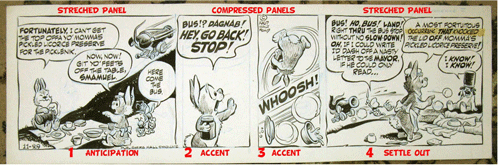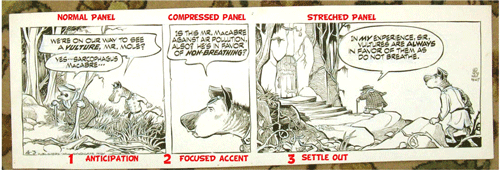Inside Sequential Comic Strips - Part 2
If you have been following along as I have been sharing my thoughts on the development of my own personal comic strip project, I have talked about the number and the relative size of the panels in a sequential comic strip and how they are used to provide pacing and timing in visual storytelling. Inside Sequential Comic Strips - Part 1
In this installment, I want to explore some other aspects of the classic comic strip, Walt Kelly's Pogo, in order to talk about some of the other tools and techniques that are often missing from usage in many of today's comics. These tools and techniques, like the use of panel variations for timing and pacing, are subtle ways for the cartoonist to enhance their strip and storytelling.

(fig. 1)
In fig. 1 above we get a great example of how the use of different font types can be applied to provide an additional form of personality and characterization. The vulture, a great bit of stereotypical casting himself, has a very unique and formal speech font that tells us as readers something more about this character's "voice". You also have to love Kelly's delicious way of naming characters, like a mortician named Sarcophagus Mac Abre.
Then we also see that the character Deacon Mushrat (instead of Muskrat, accent on the mush) has his own characteristic speech font. A very nice "Old English Script" that tells us that his voice is full of self righteousness and pomposity. Additionally notice how Kelly shaped the Deacons speech bubbles to add to his "straight laced" and "sanctimonious" tone of speech. And also notice how Kelly creates a special very ominous speech bubble style for Sarcophagus Mac Abre. Subtle little ways of accenting these characters that would be lost if they just "spoke" in ordinary fonts and balloons.

(fig. 2)
In fig. 2, we see another classic example of character specific speech fonts. This time for P. T. Bridgeport (named for the famous showman P. T. Barnum of circus fame) we see that his "voice" is a constant show in itself. His every phrase is a spectacle of colossal magnitude. Again when P.T. speaks we as readers know so much more about the character and his personality because of Kelly's use of a unique font style.

(fig. 3)
In fig. 3 we get an example of not only the usage of a character specific font type for the Deacon, but we also get to see Kelly's characteristic usage of font boldness as a means to focus his readers on specific words or phrases in a character's speech. An interesting side note is that because of the often political and social commentary involved in Pogo, there were extensive studies made by "government intelligence" organizations (an oxymoron in itself) to try to determine if the bold type words formed some sort of subversive code. If they had just understood the purpose of the cartooning technique they would have realized that Kelly was just wanting to make sure that his readers weren't missing out on the word play and all the subtle implications of his use of specific words and their implied meanings beyond their context as a character spoke. For example the term "Jack Acid" was actually referring to a bunch of "jack asses" which was Kelly's satirical dig at the John Birch Society. And his word play about combining acids and bases producing "salty doings" was expressing his perception of the society's ultra conservative right wing views. All leading to the gag in the third panel about their thinking being "off base and half assed". Kelly had some strong ideas and opinions embedded in these strips and he used the bold type to make sure the accents were not lost.

(fig. 4)
In fig. 4, we see another example of Kelly's use of bold type for accents. It is important to note that this technique wasn't just used to highlight important word play and implied meanings, as seen in fig. 3, but it was also Kelly's method of providing a comedic timing and rhythm to his comic strip. Much like a stand-up comic uses phrasing and beats to set up and deliver their monologue, Kelly was using bold type to punctuate and time his gags.
Again by studying the work of Walt Kelly we can learn more about the techniques and tools of creating masterful and highly entertaining sequential comic strips. Today's cartoonist has the opportunity to revive these techniques and apply them as part of their craft.
In this installment, I want to explore some other aspects of the classic comic strip, Walt Kelly's Pogo, in order to talk about some of the other tools and techniques that are often missing from usage in many of today's comics. These tools and techniques, like the use of panel variations for timing and pacing, are subtle ways for the cartoonist to enhance their strip and storytelling.

(fig. 1)
In fig. 1 above we get a great example of how the use of different font types can be applied to provide an additional form of personality and characterization. The vulture, a great bit of stereotypical casting himself, has a very unique and formal speech font that tells us as readers something more about this character's "voice". You also have to love Kelly's delicious way of naming characters, like a mortician named Sarcophagus Mac Abre.
Then we also see that the character Deacon Mushrat (instead of Muskrat, accent on the mush) has his own characteristic speech font. A very nice "Old English Script" that tells us that his voice is full of self righteousness and pomposity. Additionally notice how Kelly shaped the Deacons speech bubbles to add to his "straight laced" and "sanctimonious" tone of speech. And also notice how Kelly creates a special very ominous speech bubble style for Sarcophagus Mac Abre. Subtle little ways of accenting these characters that would be lost if they just "spoke" in ordinary fonts and balloons.

(fig. 2)
In fig. 2, we see another classic example of character specific speech fonts. This time for P. T. Bridgeport (named for the famous showman P. T. Barnum of circus fame) we see that his "voice" is a constant show in itself. His every phrase is a spectacle of colossal magnitude. Again when P.T. speaks we as readers know so much more about the character and his personality because of Kelly's use of a unique font style.

(fig. 3)
In fig. 3 we get an example of not only the usage of a character specific font type for the Deacon, but we also get to see Kelly's characteristic usage of font boldness as a means to focus his readers on specific words or phrases in a character's speech. An interesting side note is that because of the often political and social commentary involved in Pogo, there were extensive studies made by "government intelligence" organizations (an oxymoron in itself) to try to determine if the bold type words formed some sort of subversive code. If they had just understood the purpose of the cartooning technique they would have realized that Kelly was just wanting to make sure that his readers weren't missing out on the word play and all the subtle implications of his use of specific words and their implied meanings beyond their context as a character spoke. For example the term "Jack Acid" was actually referring to a bunch of "jack asses" which was Kelly's satirical dig at the John Birch Society. And his word play about combining acids and bases producing "salty doings" was expressing his perception of the society's ultra conservative right wing views. All leading to the gag in the third panel about their thinking being "off base and half assed". Kelly had some strong ideas and opinions embedded in these strips and he used the bold type to make sure the accents were not lost.

(fig. 4)
In fig. 4, we see another example of Kelly's use of bold type for accents. It is important to note that this technique wasn't just used to highlight important word play and implied meanings, as seen in fig. 3, but it was also Kelly's method of providing a comedic timing and rhythm to his comic strip. Much like a stand-up comic uses phrasing and beats to set up and deliver their monologue, Kelly was using bold type to punctuate and time his gags.
Again by studying the work of Walt Kelly we can learn more about the techniques and tools of creating masterful and highly entertaining sequential comic strips. Today's cartoonist has the opportunity to revive these techniques and apply them as part of their craft.
Labels: Cartooning, Sequential Comic Strips



